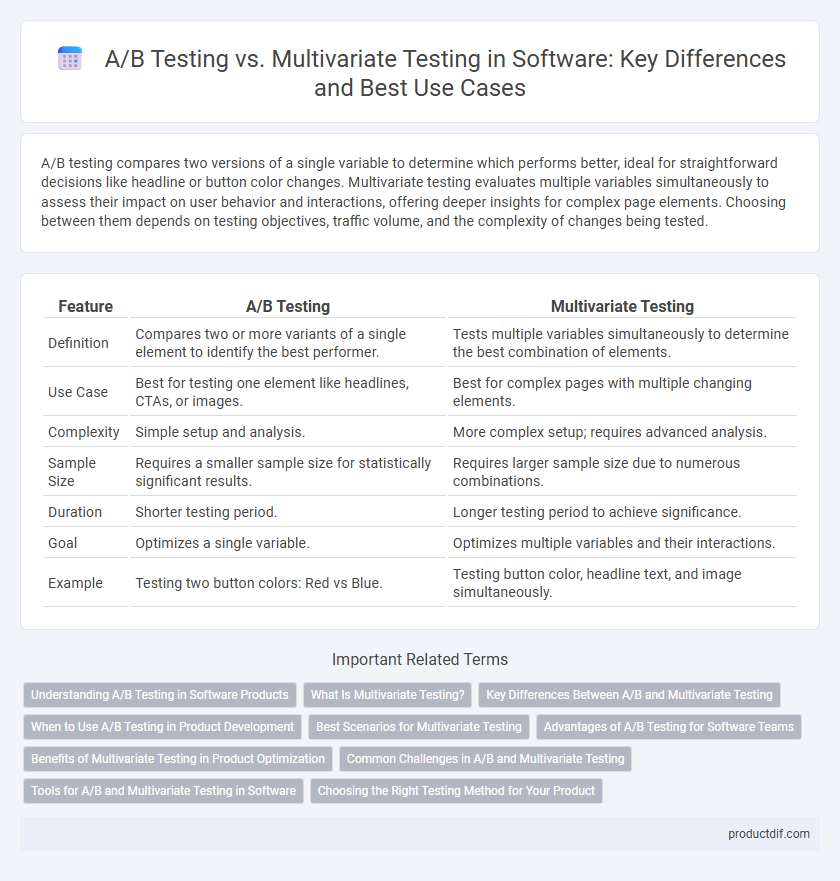A/B testing compares two versions of a single variable to determine which performs better, ideal for straightforward decisions like headline or button color changes. Multivariate testing evaluates multiple variables simultaneously to assess their impact on user behavior and interactions, offering deeper insights for complex page elements. Choosing between them depends on testing objectives, traffic volume, and the complexity of changes being tested.
Table of Comparison
| Feature | A/B Testing | Multivariate Testing |
|---|---|---|
| Definition | Compares two or more variants of a single element to identify the best performer. | Tests multiple variables simultaneously to determine the best combination of elements. |
| Use Case | Best for testing one element like headlines, CTAs, or images. | Best for complex pages with multiple changing elements. |
| Complexity | Simple setup and analysis. | More complex setup; requires advanced analysis. |
| Sample Size | Requires a smaller sample size for statistically significant results. | Requires larger sample size due to numerous combinations. |
| Duration | Shorter testing period. | Longer testing period to achieve significance. |
| Goal | Optimizes a single variable. | Optimizes multiple variables and their interactions. |
| Example | Testing two button colors: Red vs Blue. | Testing button color, headline text, and image simultaneously. |
Understanding A/B Testing in Software Products
A/B testing in software products involves comparing two versions, A and B, to determine which performs better based on user interactions and predefined metrics. This method isolates a single variable at a time, simplifying the analysis of how changes impact user behavior and conversion rates. Effective A/B testing requires careful hypothesis formulation, sample size determination, and statistical significance assessment to ensure accurate and actionable results.
What Is Multivariate Testing?
Multivariate testing is a method used in software development to evaluate multiple variables simultaneously to determine the optimal combination for user experience and conversion rates. It allows testing different variations of several elements on a webpage or app, such as headlines, images, and call-to-action buttons, in a single experiment. This approach provides deeper insights compared to A/B testing by analyzing interactions between elements to refine design and functionality.
Key Differences Between A/B and Multivariate Testing
A/B testing compares two versions of a single variable to determine which performs better, while multivariate testing evaluates multiple variables and their interactions simultaneously. A/B testing is simpler and requires less traffic, making it ideal for straightforward changes, whereas multivariate testing demands more data to effectively analyze combinations of variables. The choice depends on the complexity of the testing goals and available sample size.
When to Use A/B Testing in Product Development
A/B testing is ideal in product development when comparing two distinct versions of a single element, such as a webpage layout or call-to-action button, to identify which one yields better user engagement or conversion rates. It is especially effective for testing changes with clear hypotheses and straightforward performance metrics. This method enables rapid decision-making and incrementally improves product features without the complexity of analyzing multiple variables simultaneously.
Best Scenarios for Multivariate Testing
Multivariate testing is best suited for complex software interfaces where multiple variables, such as button color, layout, and text, need simultaneous evaluation to identify the optimal combination. It excels in scenarios with high traffic and sufficient sample sizes, allowing statistically significant insights across numerous variable interactions. Multivariate testing effectively optimizes user experience on dashboards, e-commerce product pages, and feature-rich applications by revealing how different elements interact and impact user behavior.
Advantages of A/B Testing for Software Teams
A/B testing offers software teams a straightforward method to compare two versions of a feature or interface, enabling rapid decision-making based on clear user behavior data. This approach requires fewer resources than multivariate testing, making it ideal for teams with limited time or budget constraints while ensuring statistically significant results. By isolating individual variables, A/B testing minimizes complexity and helps teams identify specific changes that directly impact user engagement and conversion rates.
Benefits of Multivariate Testing in Product Optimization
Multivariate testing enables simultaneous evaluation of multiple variables within a product, providing deeper insights into complex interactions and user behavior compared to A/B testing's binary approach. This method accelerates data-driven decision-making by revealing the most effective combinations of features, design elements, and content variations, ultimately enhancing user experience and conversion rates. Leveraging multivariate testing improves product optimization by uncovering nuanced performance patterns that single-variable tests may overlook, leading to more precise and impactful enhancements.
Common Challenges in A/B and Multivariate Testing
Common challenges in A/B testing involve maintaining statistical significance with limited sample sizes and controlling external variables that can skew results. Multivariate testing faces complexities in analyzing interactions between multiple variables, often requiring larger traffic volumes to achieve valid conclusions. Both methods struggle with issues like test duration optimization, user experience consistency, and accurately attributing conversion changes to specific test elements.
Tools for A/B and Multivariate Testing in Software
Popular software tools for A/B testing include Optimizely, VWO, and Google Optimize, which offer user-friendly interfaces and real-time analytics to compare two versions of a webpage or app feature. For multivariate testing, platforms like Adobe Target and SiteSpect provide advanced capabilities to test multiple variables simultaneously, enabling detailed insights into interaction effects. Both types of tools integrate with popular analytics platforms such as Google Analytics and Mixpanel to enhance data-driven decision-making in software development.
Choosing the Right Testing Method for Your Product
Choosing the right testing method for your product depends on your goals, complexity, and available traffic. A/B testing is ideal for comparing two variations of a single element, offering clear insights with lower traffic requirements. Multivariate testing analyzes combinations of multiple variables simultaneously, providing deeper insights but demanding higher traffic volumes and more complex analysis.
A/B Testing vs Multivariate Testing Infographic

 productdif.com
productdif.com